Caution on copyright should you wish to use photographs and diagrams from my website. I have included attribution wherever known and attempted to seek permissions from authors/owners of copyright who could be still found. This was not possible in all cases as the source of the photo was unknown or no longer in existence.
As stated in the section titled “BEAH Gatwick”, Jock Cameron, Managing Director of BEAH, had somehow persuaded the Board of BEA to purchase two S61N helicopters from Sikorsky in Connecticut, USA. One of these was destined for a new helicopter service linking the mainland to the Isles of Scilly. Hitherto, this service had been operated by a De Havilland Rapide flying from Lands End aerodrome to St. Mary’s aerodrome in the Scillies. The only other means of travelling between the mainland and Scillies was via the “Scillonian”, a relatively small motor vessel based in Penzance harbour. Due to the shallow harbour, this boat had a relatively small water draft (small depth of keel) and was thus subject to an unpleasant rolling motion in anything but good sea states. A specialised heliport was built on East Green just to the east of Penzance and the service commenced operations in 1964 under the management of Captain Ron Dibb. It soon became successful and became an intrinsic part of the local scene. The demand for seats and therefore flights was limited in Winter but in Summer the helicopter flew from dawn to dusk on its 20 minute per sector operation.
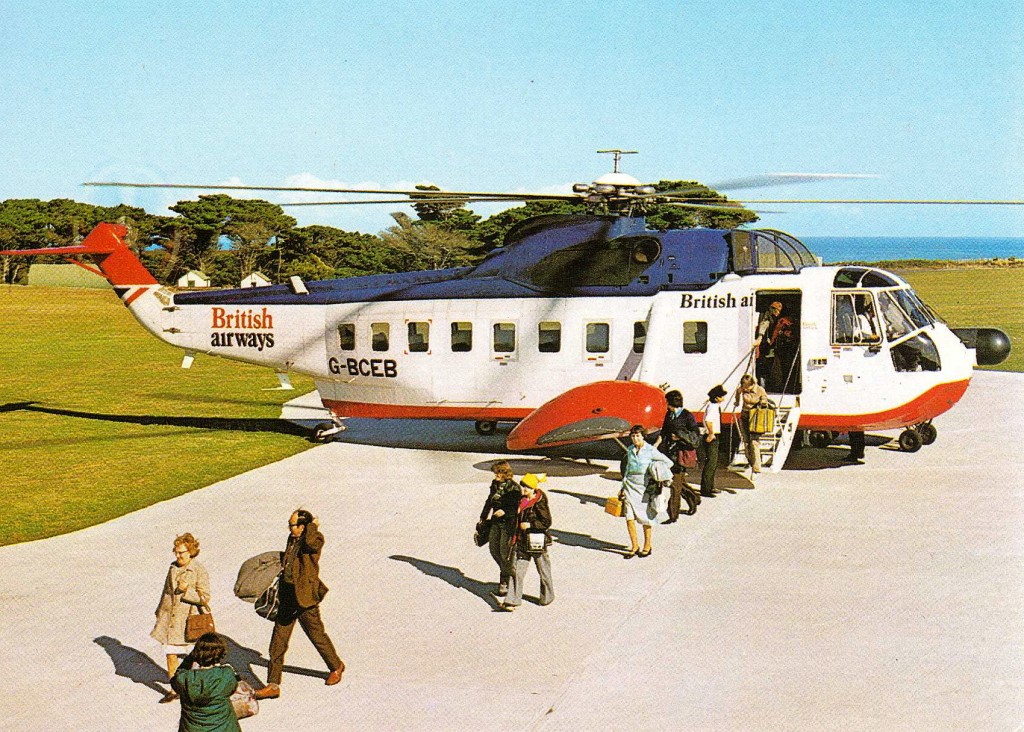
ST MARYS – ISLES OF SCILLY
This helicopter, G-BCEB, was obtained several years after the start of the service in 1964. It is an S61NM, the main difference to the S61N being that the top of the starboard chine is vertical and includes five baggage hold doors. This and some clever design by BAH Engineering at Gatwick, who had Design Approval, permitted the installation of a sideways facing seat along the port rear of the fuselage giving a 32 passenger seat configuration – the most in any S61 helicopter.
Although I had found the job of Manager and Chief Pilot in Shetland both demanding and, at times, very rewarding, it had its limitations. The three children enjoyed living there but for my wife, Margaret, it lacked many of the advantages to be found on the mainland. Jock Cameron wanted me to extend my two years to four. I agreed to make it three at the end of which my high seniority in the company guaranteed me the first vacancy at the choice posting of Penzance. We sold our bungalow in Shetland to BAH for a residence for the new manager, Robin Zingel, the first non-pilot manager in BEAH or BAH, and moved south to a bungalow just west of Penzance.
I suppose it could be said that if Shetland was the most demanding of operations, Penzance was the most exotic! There were even palm trees growing around the terminal building. In Winter the passengers were normally locals and others with business interests but during the Summer the service transformed into a holiday run with holidaymakers with accommodation booked on the Scillies or day-trippers, many of whom would experience their first ever helicopter flight. The clearance from the cabin attendant that all the passengers were seated and strapped in was “All is proper in this chopper”, spoken with a strong Cornish dialect.
The operation had been under VFR (Visual Flight Rules) but with the advent of the IFR (Instrument Flight Rules) capability pioneered for helicopters by BAH, Captain Mike Perkis, the manager of the operation, asked me to develop a cloud break procedure to permit us to fly in low cloud yet achieve a safe approach and landing to St Mary’s airport in the Scillies and reverse the procedure for returning to Penzance. Such a procedure was developed using the Decca Navigation moving map display as installed as standard on the helicopter, combined with the Lands End VOR (a radio beacon on the airfield at Lands End providing signals giving bearing and range to an instrument on the dashboard of the helicopter). Once approval had been received from the CAA, we were able to take off from Penzance and disappear into low cloud, fly safely towards the Scillies and then descend to the minimum descent altitude of 200 feet above the elevation of the airfield at St Mary’s and land safely. Returning to Penzance employed a similar procedure descending over the bay by St Michael’s Mount with descent to 300 feet above the sea.
We flew in just about all weather conditions, sometimes in rough conditions with strong winds. It was amusing to read a local newspaper article praising “Royal Navy heroes” referring to a flight carried out in stormy weather from the nearby Royal Navy station at Culdrose. We had been airborne at the same time flying our service with numerous passengers on board!
I have to confess to a certain mischievous practice. When flying over the Scillonian one would announce on the cabin address “…we apologise for the slight vibration but if those on the right hand side of the aircraft would care to look down you will see the alternative means of travel – the Scillonian.” They would see the Scillonian plunging up and down as it battled through the waves. There was a not funny side to this as, on occasion, the boat passengers could suffer various injuries and would then be ferried back to the mainland by helicopter!
Article from Shell Aviation News 1976 (reproduced by kind permission)
British Airways Helicopters Ltd., formerly BEA Helicopters, provides a scheduled service linking the Isles of Scilly with Penzance in the far south-west of England*. This operation, with its regularity factor of 98%, can claim to be one of the most reliable airline services in the world and now carries more than 80,000 passengers a year in a single Sikorsky S61NM.
Such results have been achieved under VFR Visual Contact conditions during the twelve years of the service’s existence, viz. en route weather minima of 300 ft cloud ceiling and visibility of 900 metres. However, there are certain situations when en route weather is below limits even though weather at both ends of the route is above VFR minima. Sea fog is a particular nuisance in this respect. It was therefore considered worthwhile to investigate an IFR capability to overcome the en route problem. As BAHL pioneered the introduction of commercial helicopter instrument flight in Britain, the considerable experience gained on North Sea operations for the oil companies encouraged the prospect at Penzance.
Considerations
The VFR minima at Penzance (elev. 14 ft) are 300 ft cloud ceiling and 900 metres visibility, while at St Mary’s, Isles of Scilly (elev. 116 ft) they are 200 ft and 900 m. A feasible IFR operation would need to have minima equal to or less than these. In order to achieve maximum utilization of the one aircraft, the daily schedule packs up to 24 sectors, each of about 20 minutes, totalling 11 hours and 15 minutes elapsed time including 8 rotors running refuels and 3 rotors stopped refuels/turnrounds. Any innovation could not be allowed to increase sector times significantly and so, ideally, the approach at both ends should approximate to the direct track between Penzance and Scilly.
St Mary’s has only a VDF facility, thus a Decca approach along the 249o radial from the Lands End VOR (LND) was favoured, using airborne radar for an extra check on range and azimuth. At Penzance an approach from the Lands End VOR down to Mounts Bay on a radial of 125oM was most convenient. In precise terms both of these approaches are ‘cloud break procedures’ and the aircraft must have completed the instrument descent at three miles prior to touchdown.
The draw-back to IFR procedures as opposed to VFR is the extra fuel required and therefore the reduced payload available. The S61NM, a partially amphibious conversion of an S61L, has 30 passenger seats and a maximum all-up weight of 20,500 lb.
On this route, the minimum VFR fuel of 1200 lb ex Penzance allows flight to St Mary’s and return to Penzance with 400 lb loiter fuel remaining in the tanks. Fuel for IFR would be this 1200 lb plus an extra 320 lb, giving a total of 45 minutes loiter, plus diversion and approach fuel to St Mawgan of between 450 lb and 780 lb dependent upon wind. This could be reduced if fuel were made available at St Mary’s but so far this has not been considered worthwhile.
St Mawgan (elev. 392 ft) is a Master Diversion airfield on the North coast of the Cornish peninsula, and has an NDB, ILS and PAR. It is the only suitable diversion airfield available to the S6INM with its limited fuel capacity of 2550 lb. The only other airfields within range are R.N.A.S. Culdrose and the small civil airport at St Just (Lands End). Culdrose, a mere seven minutes Hying from Penzance, has PAR; however, with an elevation of 268 ft it rarely experiences better weather than Penzance and is not available for diversion at weekends or holidays, our busiest periods. St Just has no approach aid and weather disadvantages similar to Culdrose.
Despite the reduced payload with IFR fuel, equivalent to as many as six passengers, the ability to fly on time far outweighs the consideration of a poorer load factor. On peak days, such as a Wednesday or a Saturday in summer, there are frequently more than 700 passengers to be flown, nearly all of whom are starting or finishing a holiday on the Isles of Scilly. If helicopter flights are cancelled, these passengers have to be accommodated overnight, which can prove impossible. Over the twelve month period, some 22% of the passengers are day-returns who usually book at short notice; should there be a payload problem, it is these who would be invited to spend their day elsewhere.
Typical operation
A typical IFR flight could be as follows. After the initial climb-out at 20 kt from the Penzance Heliport, the aircraft is rotated at Decision Point to 80 kt, and shortly afterwards enters cloud. A climbing turn is made over the sea to a cruising altitude of 2000 ft (Reg. QNH) on to a track to cross the LND VOR. Deccometers and Flight Log are checked and up-dated overhead the VOR, after which a QDR of 249oM is maintained towards Scilly. Decca Flight Log and VOR indicators are cross checked and should agree within one Decca Lane. When the Eastern Isles of Scilly are shown by the airborne radar to lie at a range of 12 miles, the Decca Flight Log is checked to agree.
Some eight miles from touchdown, with all approach checks completed, a descent is initiated according to the track and heights as shown in the Decca Flight Log. These provide a 3o glide slope. The pilot handling the controls responds to corrections in height and heading as given by the other pilot from the Decca Flight Log and radar picture. The Decca is used as the primary aid with the radar and VOR as confirmatory aids.
At three miles from touchdown, at a height of 200 ft (QFE), visual contact is made with the sea and the aircraft is flown level, holding the decision height. Continuing to read information from the flight log, radar and VOR the pilots maintain decision height until either sufficient visual cues for a landing become available or an overshoot is initiated. During these final stages of the approach airspeed is reduced to 70 kt. The continuing of an approach at low level and low airspeed, even after decision height has been reached, allows the extreme manoeuvrability of the helicopter to be exploited in complete safety. With the variety of aids in use there is no possibility of collision with the only significant obstacle on Scilly (a radio mast). Familiarity with the radar picture gives confident identification of the island of St Mary’s and even the airfield itself. Another bonus with the radar is the knowledge that the QE2 passenger liner, or a supertanker, is not parked in the undershoot.
After five minutes on the ground at St Mary’s, during which time perhaps 30 passengers have disembarked and another 30 climbed on board, the aircraft lifts off again. Passing through a decision point of 50 ft (the take-off area at St Mary’s permits a different take-off technique from that used within the confines of Penzance), the aircraft climbs to 2,000 ft (Reg. QNH) on a direct track for the LND VOR.
A few miles short of LND track is adjusted to bring the aircraft 3 n miles from the VOR on to a QDM of 125o. This QDM is maintained over the VOR and thereafter a QDR of 125o. For the 3 n miles before the VOR and 1 n mile after, height is maintained at 2000 ft (Penzance QFE); this allows the tracking accuracy of the Decca to be checked against the VOR. In addition, the radar picture is scrutinised to check the range of Cudden Point in order to confirm the fix. The duties of the pilots during this approach arc similar to those for the Isles of Scilly approach. Visual contact with the sea is made by the Decision Height of 300 ft, following which the aircraft is turned on to a Northerly heading for a visual approach to the Heliport.
CAA approval to begin commercial IFR operation was granted at the end of May 1976 for the Penzance/Scilly helicopter service. The procedures at both ends arc straightforward, and are enjoyed by the five resident Penzance pilots. Since neither involves undue extension of flying times, pilots can practise instrument approaches more frequently than would otherwise be commercially desirable. Instrument flight adds another dimension to the repetiveness of the VFR operation.
Future Developments
For many years now, some military helicopters have had the capability for hands-off zero visibility approach and landing. So far such a capability has not been developed for and taken up by commercial aviation. BAHL has conducted trials on MADGE (a microwave approach guidance system)** with great success, but the installation of such equipment cannot yet be justified commercially. It would probably require MADGE and high intensity lighting to allow us to complete manual approaches in fog. Probably the most likely improvement that could be made to our IFR operation would be an NDB located on the Penzance Heliport and one on St Mary’s Airfield. These, together with the experience gained during several hundred instrument approaches, might encourage CAA approval of a slight reduction in the IFR weather minima.
•See SAN 404 & 405/1972. ‘West Country Airline” by British Airways Helicopter* Ltd’s Managing Director Captain j. A. Cameron.
**See SAN 429/1975 Tor an evaluation of this system by F. W. Free, Project & Performance Engineer, British Airways Helicopters Ltd.

In the BAH S.61 NM, Ecko 290M Weather/ Mapping radar and a radio altimeter have been installed together with Collins VHF/VOR and ADF. Decca Mk 19 equipment replaces the former Mk8A. This flight deck shot shows a westbound IFR en route descent in sea fog, about 4 miles from touchdown at St Mary’s, during the final stages of the cloud break procedure
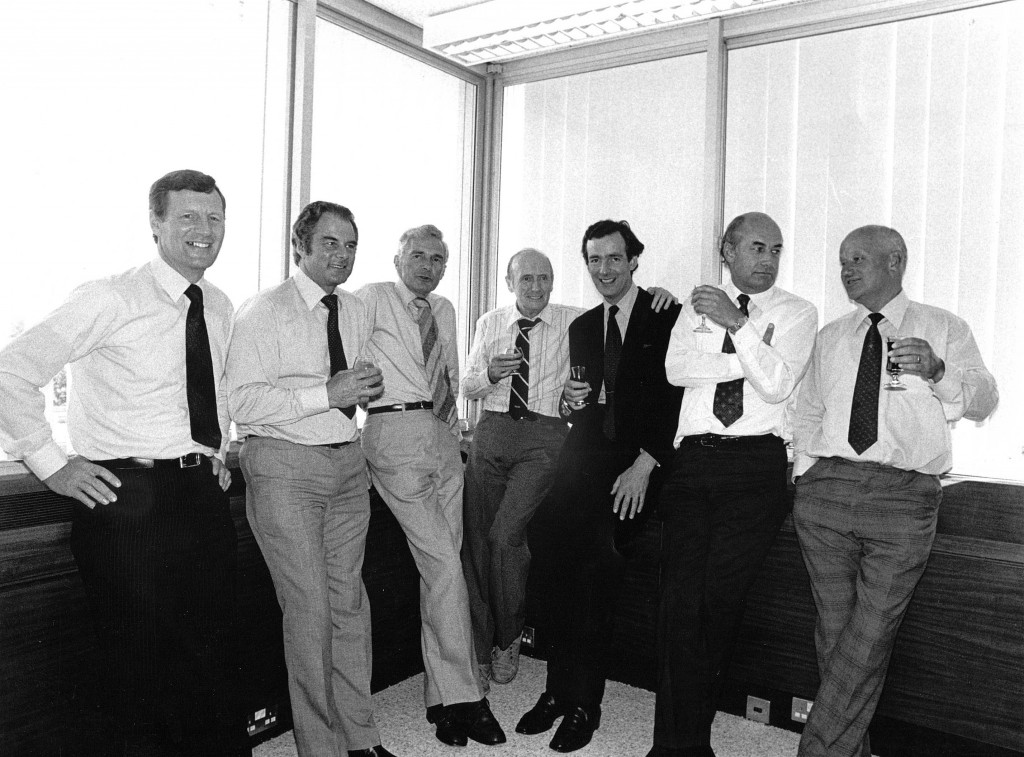
THIS PHOTO IS PLACED HERE AS IT DOES NOT FIT ANYWHERE ELSE. IN 1982 BRITISH AIRWAYS SCALED DOWN AND IN THE PROCESS OFFERED SEVERANCE DEALS TO ALL STAFF IN THE GROUP. A NUMBER OF BAH PILOTS TOOK UP THIS OFFER AND THE SHOT SHOWS OUR FAREWELL DRINK. TO MY LEFT- DOUG DURRANT, SANDY SANDERS, [FRED CHARLTON – ENGINEERING DIRECTOR], LORD SIMON GLENARTHUR, MIKE PERKIS AND JIM SUMMERLEE.
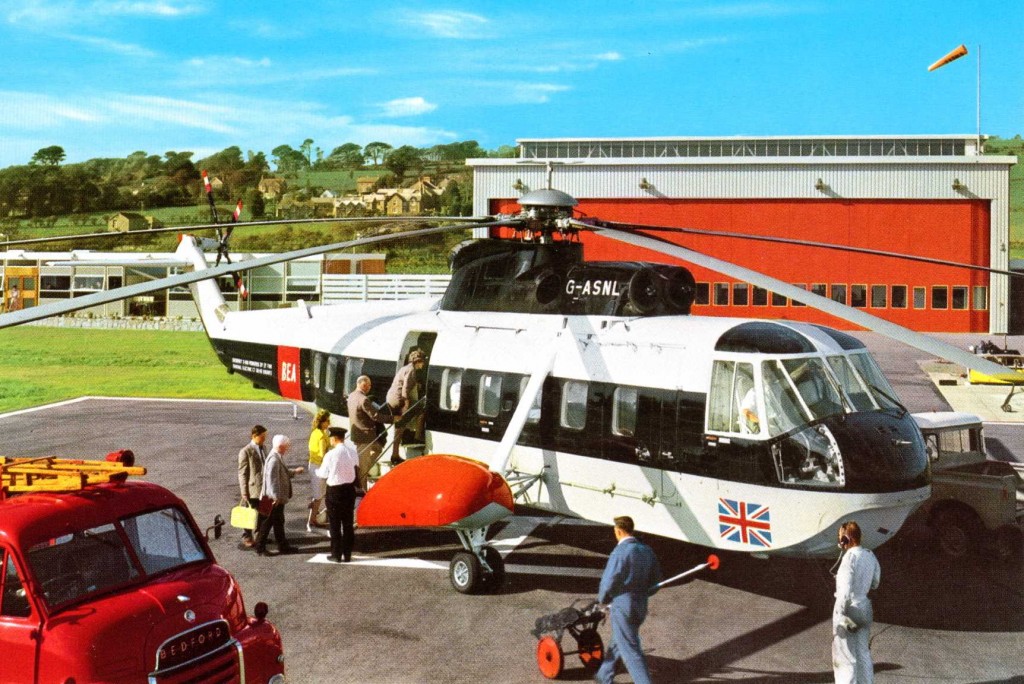
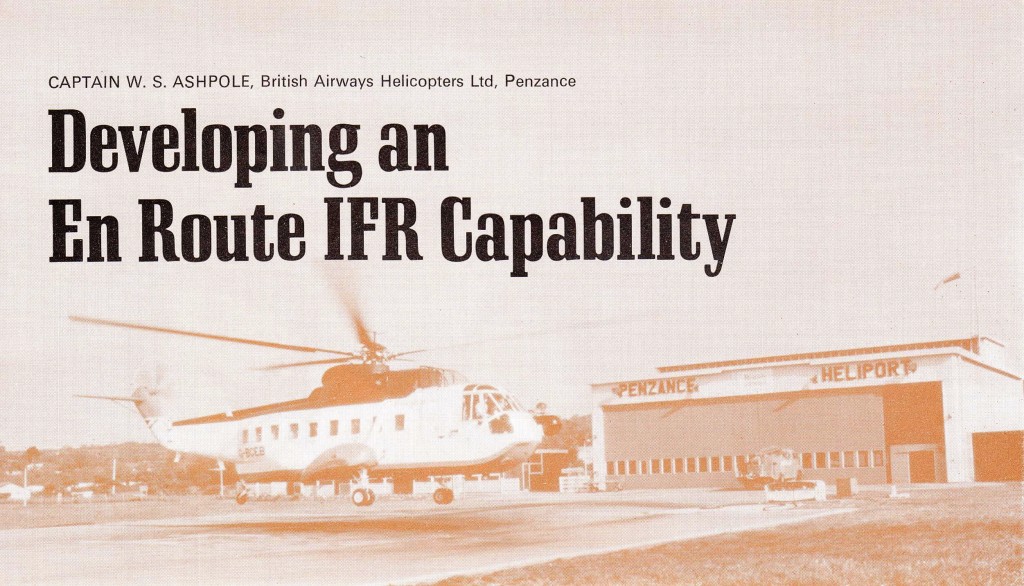
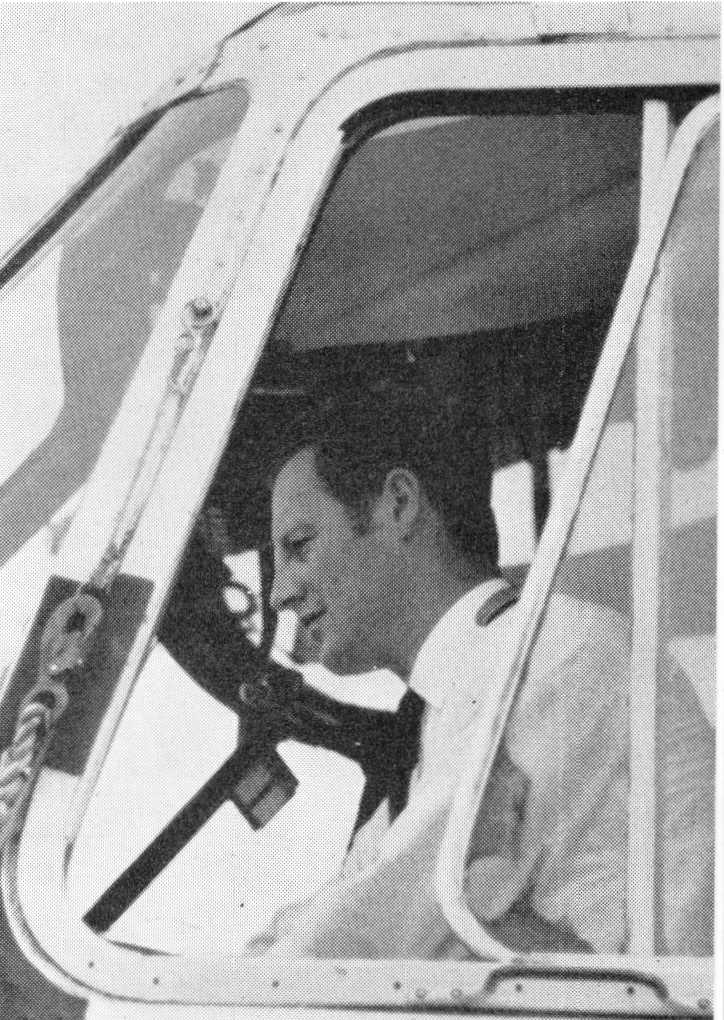
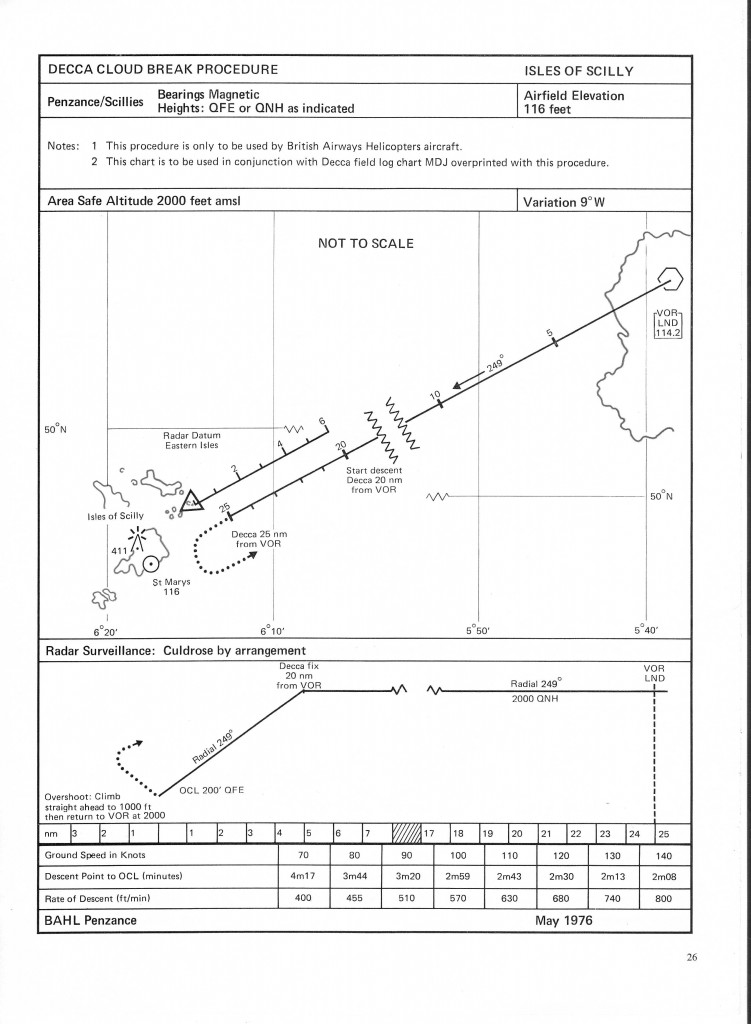
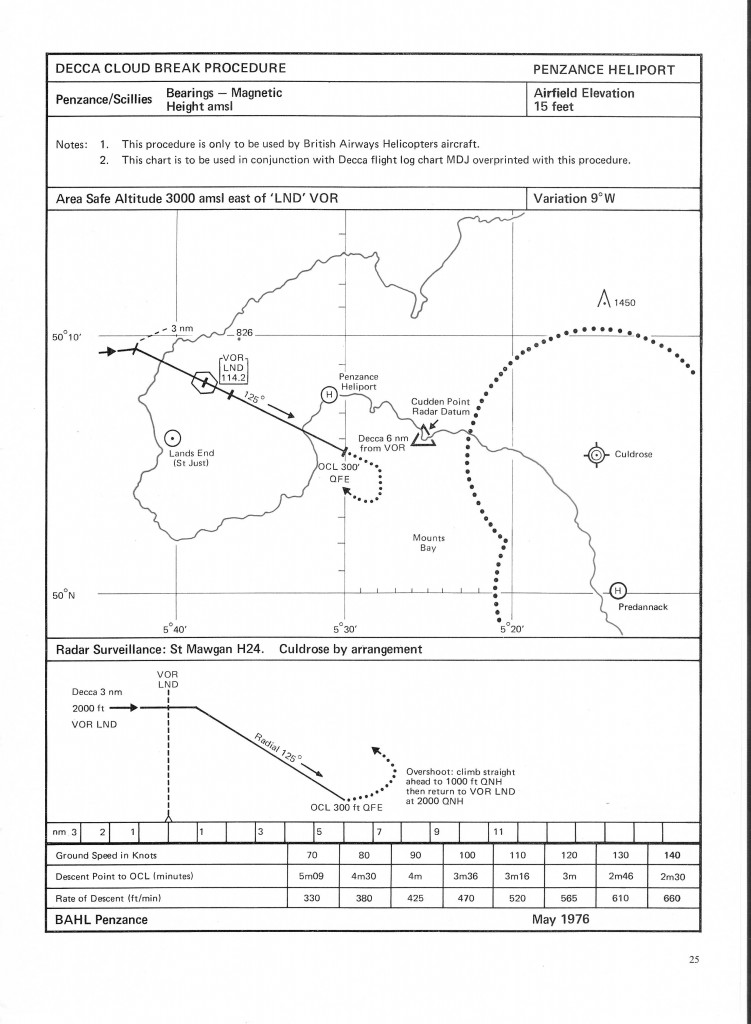
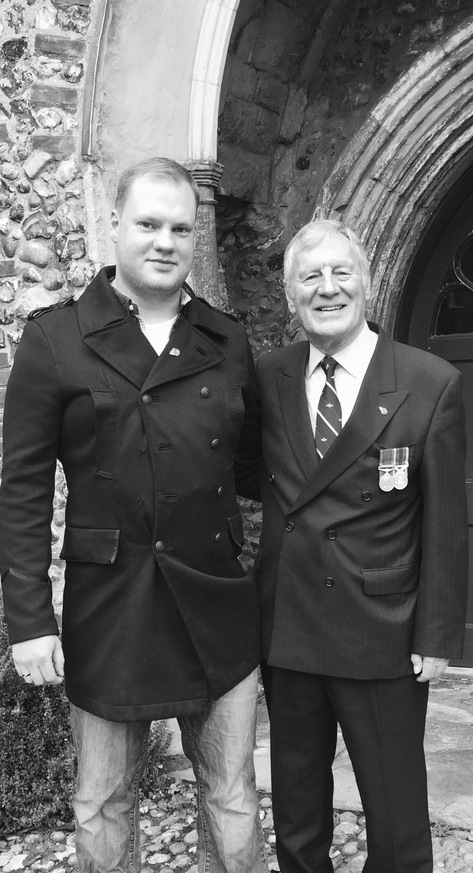
Hi, my wife flew to the Scillies in she thinks the early 70s ,she thought the helicoter had twin rotors?, was this ever the case. Must say did enjoy reading this article.
cheers Roger.
Hi Roger
I am sure that only the S61N or S61NM were employed to the Pensance/Scillies route in the 70’s. BAH bought 4 or 5 Boeing 234 [Commercial version of the Chinook] helicopters at the end of that decade for use out of Aberdeen. I will check with Terry Nelson who became manager of the Penzance operation of BAH and revert if I am wrong. Thank you for your kind comments about the blog.
best wishes
Bill Ashpole
Dear Bill, What a brilliant page this is, i flew the route from the age of 1 in 1970 on G-ASNL and continued to use it right up until the end in 2012.
I really miss seeing the Heliport in Penzance but hope the new one will go ahead, remember Jim Blain and Terry Nelson flying us and i am sure you did too.
G-BCEB is now lifting logs in Portland Oregon for Cromer helicopters and NL is still flying in the states amazing!
Hi Jonathan – thanks for the comment – I am pleased that you enjoyed the blog. I am still in contact with Terry Nelson who retired to Northern Ireland. Tom Hooper is another regular contact as seen from the photos in the 225 Squadron section. Sadly, a number of former colleagues have passed on. The fate of G-BCEB is similar to that of G-LINK – logging in South America and then scrap. I was not aware of any plans for a new heliport in Penzance. Perhaps you would enlighten me?
Read: http://www.itv.com/news/westcountry/2017-01-04/row-over-new-penzance-to-isle-of-scilly-helicopter/
And: http://penzanceheliport.co.uk/
Hi Micky – thanks for adding the link. I had no idea that this new service was being planned and wish it all the very best. I will send the link to Terry Nelson who managed the previous service for many years until its cessation and was its longest serving pilot.
Best regards
Bill Ashpole
As a child we flew to the Scillies. Still have the BA flight ticket in my scrapbook.
I’m sure we took off fairly horizontally from Penzance, landing vertically. I recall feeling a bit shortchanged as an eight year olds first helicopter flight…. I’m 50 now and am reminiscing about the alternative to the wallowing Scillonian which mum refused to take. Wasn’t that an old RO-RO ferry?
Am I right in my take off recollection?
Hi Tim
Thanks for your comment. I am puzzled by your observation concerning the “fairly horizontally” take-off. Let me check with a former colleague and come back to you.
Best regards
Bill Ashpole
Hi Tim – I have been in touch with Captain Terry Nelson, the longest serving pilot on the operation who became its manager until its demise. He confirms my own thoughts.
Your expectation may have been for the helicopter to climb and descend vertically. When flying a twin-engine helicopter one has always to consider the possibility of one engine failing and the resultant need to land or continue the flight safely. Like most twin-engine helicopters, the performance of the S61 does not permit a hover on one engine with anything other than the lightest of payloads. Therefore, the take-off technique employed must be such that the helicopter can either land back on the helicopter strip and stop in the very limited distance available, or continue flight to return for a safe landing powered by the remaining engine. Two such techniques were authorised for the Penzance operation, one climbing initially at 20 knots airspeed to a pre-calculated height above the ground, and the other at a higher airspeed to a height of 50 feet above the ground. I suspect that it was the latter technique that you experienced. This technique would only have been applied if conditions allowed since the first technique was always employed in the more limiting conditions of light winds, high temperatures and with high payload.
As for take-off technique, landing technique has to take account of the possibility of one engine failing. The handling pilot on your flight would have commenced his final descent with 25 or more knots airspeed which he would have maintained until the last few seconds. You will rarely see any helicopter descend vertically at a high rate of descent because of a phenomenon known as “vortex-ring”, a very dangerous condition somewhat akin to the stall on an aeroplane.
I don’t believe that the Scillonian III is a RO-RO ferry and its predecessors weren’t either. Plans to fund a RO-RO replacement were abandoned. I do know that the helicopter service benefitted from the occasional very rough crossing made by Scillonian passengers on the Penzance to Scillies sector.
I hope you find my comments useful.
Best wishes
Bill Ashpole
I thought the helicopter came into service in 1964!
Hi Frances
That is correct. I mention this date in the introductory paragraph to the operation. Have I got it wrong elsewhere?
Best regards
Bill Ashpole
Hi Bill Ask Terry about the ‘Islander’ that used to go into low level ‘Warp’ mode to get ahead of the 61 to avoid the landing turbulence. Sat mornings good fun with 5 islanders, 61 and the Westland flying Shed (freq with Max) all competing in the race with no rules.
PC
Windsock still flying from Sainsbury’s PZ and EB’s chocks in use at Lelant International.
Hi Peter – thanks for your comment – sounded very interesting
Terry replies as follows:
Hi Bill,
Pete is a Dear long time friend who used to fly for Skybus on a pretty regular basis.
Many thanks,
Terry.
Ps He could never beat us in the S61 especially when the weather was poor..
We have been reading your blog with interest.
My husband and myself flew to Scilly in August 1964 for our honeymoon.
Perhaps you were the pilot?!
The next time we went ? 65,?was from Eastern Green and we have returned frequently with children and now grandchildren all of whom accompanied us to celebrate our Golden Wedding on Tresco in 2014. Wonderful.
We are particularly concerned because the Steamship Company are being obstructive regarding the current plans for the new heliport in Penzance.
We would be so interested to know what the reasons were for the original location in the 60’s to move from Land’s End to Eastern Green . Not too much technical explanation though!
Presumably they wouldn’t be so very different for the reasons today.
We have recently experienced holiday plans seriously disrupted (5days) due to low cloud and too few pilots available.
We don’t remember such on going problems with the helicopter.
We are very frustrated on behalf of Penzance Heliport, as there seems to be no case for using Land’s End ( owned by Steamship co.) as a heliport.
Very best Wishes
Jane and Keith Lovell.
Dear Jane and Keith – thank you for your post and interest.
Firstly, please let me send belated congratulations on your Golden Wedding in 2014 – how appropriate to return to the Scillies where you spent your honeymoon.
The advantages of Eastern Green are twofold. Firstly, it is adjacent to the railway station and on the edge of the town of Penzance – so very convenient for passengers. Secondly, the heliport is almost at sea level. St Just is over 400 feet above sea level. Low cloud, as you know well, can be a severe problem for air services in that area. The helicopter could be flown visually in complete safety at 250 feet above the sea all the way to St Mary’s. Meanwhile, St Just could remain in cloud all day.
It is a pity that the steamship company is fighting the re-introduction of a helicopter service but one can understand their commercial motives. I hope the day will come when you will be able, once more, to enjoy the helicopter flight to your special destination.
Best regards
William Ashpole
Bill,
I was flying with Jim Summerlee (leave relief co- pilot). I asked how often he had been to Scilly. Back at PZE we checked his log book.at that time he had been 11,000 times. I wonder what his final total was?
Kind regards,
Stewart
Replied privately
Bill Ashpole
Hi Bill,
I joined BEAH in May 1964 as Flight Clerk with £2 a week flying pay, only two of us to operate on G-ASNL and G-ASNM from St Just airfield, we moved to Penzance in September of that year.
The pilots were Captains Doug Pritchard, Jim Summerlee ,and first officers Bob Simpson, and —- Evans. Captain Jock Cameron would sometimes turn up and fly. Later I remember Mike Perkis, Tony Collins, Dave Eastwood, Ron Dibb, , Dick Sadler and Tom Price.
At first we had to shut down after landing at St Marys, but later introduced “rotors running turn around” both at Scilly and Penzance to speed up the operation. We used to take P.M. Harold Wilson and his wife over quite regularly from Penzance, and I was there during the Torrey Canyon disaster, I left in late 1967.
Regards Paul Leggo
Hi Paul – many thanks for your interesting historical contribution – some key names there – sadly, most of whom have passed away. You were certainly in at the beginning of that amazingly successful service – I venture to say the longest running scheduled helicopter service in the World. You may have read that another company is trying to set up a new helicopter link but is being vigorously opposed by the steamship company. My first visit to PZH was also my first commercial flight int he S61N – commanded by Jock we flew to Jersey with Wynn Jones as our cabin attendant – did the Battle of Flowers and then flew on to PZH to do a few sorties there. I think this would have coincided with your time there. Best wishes Bill Ashpole
Hi. My late father and I flew on this service to The isles of Scilly sometime between 1979 and 1982 (from Penzance). I think it’s more likely it was in the early 80’s, though I can’t be sure. Like one of your other contributors, I seem to remember one of the flights was on a twin rotor Boeing. Is this possible? I know the Sea King was used normally on this route. Could the Boeing have been used due to operational or some other issue, just for a few flights? The other flight was definitely on a Sea King, although I don’t recall if this was on the way to or from Penzance. I’d be grateful if you could let me know if the Boeing was ever used on this route. I thoroughly enjoyed reading your article. Thanks 8n advance. Dave Plews.
HI David – thank you for your interest. I have written to Terry Nelson, who was the longest serving pilot on the service and became the manager until its end. I will let you know when he responds.
Best regards
Bill Ashpole
Hi again David
Terry, who flew some 45,000 sectors on the Penzance/Scillies helicopter service, confirms that at no time was a Chinook utilised.
That still leaves somewhat of a mystery as to why two separate individuals thought they witnessed a Chinook at Penzance.
Best regards
Bill Ashpole
Both myself and a companion remember flying from the older airport in Central Penzance on a twin engined helicopter. So I am pretty sure it happened, even if only once! As the company did own twin-engined Boeing helicopters, that seems to confirm our experience.
Hi Bill. Sorry for the delay in replying. Thanks very much (and thanks to Terry, also) for taking the time to clarify this for me. My memory has obviously let me down after all these years! Regarding the timing, I dug out an old diary, and our flight out to St Mary’s from Penzance was on Saturday August 29th, 1981, and we flew back to Penzance on Saturday 5th September, at 8:25 AM. It’s nice to finally confirm I flew on the Sea-King both ways! Somewhere, I have a terrible photo I took from inside the cabin on one of the flights. It’s very over-exposed, and the only thing visible through the window is the large red cowling over the Starboard wheel! (Apologies if I’ve already mentioned that in a previous post). It would be interesting to know if any of the BA twin rotors passed through Penzance, as it might explain the confusion – although it seems more likely it’s probably just poor recollection on my part, and that of your other contributor. I flew to and from Scottish airports a few times in the 80’s – so I may well have seen one there. I think they were mainly used to transport crew to and from the North Sea Oil Rigs. Anyway, thanks again for your help, and keep up the good work. Kind regards, David.
Hi David
Well, that diary proved useful. The red cowling over the wheel on the Sikorsky S61N is, in fact, a watertight sponson. The two sponsons stabilise the aircraft laterally during a ditching. The S61N should not capsize provided the wave heights do not exceed 6 feet so – not good news over the North Sea and sometimes off Penzance! I think it very unlikely that a BV234 belonging to BAH or subsequent companies ever passed through Penzance. There would be no relevant mission. It is very likely that you saw one in Scotland. BAH bought 5 BV234 aircraft. With their larger range and payload (44 passengers) they could fly direct from Aberdeen to many of the rigs thus removing the need for fixed wing aircraft for the Aberdeen/Sumburgh leg.
Best regards
Bill Ashpole
This thread is Solid Gold…!
Thank you for posting.
I lived in Penzance/ Newlyn from 1975 to 2016, so never far from the flight-path.
Can confirm I never saw a BA Chinook type.
There was an Augusta shaped aircraft used esp in summer, in the later years.
Very pronounced rotor noise in front.
I did a few seasons of agricultural work on st Mary’s ’76+’77 I think.
I got the first one through the Job Center and because BEA was nationalised and Scillonian a private enterprise, they gave me a helicopter ticket (one way..!)
The Queen’s Silver Jubilee one of those years, I remember Her and P.Phillip flying in over our fields!!.
Note: I think the windsock features on navigation charts for the Bay, and that’s why it’s still there on Sainsbury’s roof.
I don’t think it was a gesture of remembrance for the Heliport.
“All proper in the Chopper”….
I love it…..
Dear Rob
Thank you for your kind comments regarding the website. I hope it brought back some happy memories of the helicopter service and especially of the special area around the tip of Cornwall.
Best regards
Bill Ashpole
Interesting article and comments Bill. My father was Ron Dibb, the manager in the sixties, starting at Lands End while the heliport was being built. Prior to the move to Penzance he spent months at Sikoski in Conneticut learning to fly the 61N coupled with the mechanical engineering so he could train other pilots and engineers on return to Gatwick. The first 61N was put in BEA livery and we had a photograph of it flying over New York – we sent it to the BA museum for posterity back in 2007. That aircraft was shipped over on the Queen Mary, assembled on Southampton dockside, flown to Gatwick and had all the american wiring replaced with UK stuff to comply with CAA regulations! Dad retired in 1972 because he went slightly deaf.
In later life he talked about his time in the old experimental unit and I expect you have read the history. Some exploits come to mind. The early 1950s helicopter evacuations when there was flooding in Holland, hovering over the east coast out at sea so directional radar installations could be configured, towing targets (on a very long tether!) used for practice by air defences, early testing of Decca radar in aircraft, crop spraying, transporting VIPs (he flew the signatories and landed on the M1 for the opening ceremony), outdoor sport filming eg the TT races for the BBC, postal services around the country, he flew the first helicopter into London to land by the Thames to see3if there were any complaints (the old 51s were noisy) – only one apparently. Then there were flights to Paris to see if they were viable and flying film cameramen eg Bond films, the Beatles (they just added “tles” to the “BEA” ) and others. More recently I came across a picture of him with Sabrina (and helicopter) whose name I googled at someone’s suggestion. He also told me that at one stage he was the signatory on helicopter pilot’s licences. I know that in the early sixties the Duke of Edinburgh summoned him to Buckingham Palace to discuss flying helicopters but what became of that I don’t know. I was still young at that time but it wasn’t long after that when he had to go to the States.
I remember Jock Cameron, Jim Summerlee and Mike Perkis.
Malcolm – thank you for your interesting notes on the early days of the BEA Experimental Helicopter Unit and for reminding me of your father. I met him on my first series of flights with Jock Cameron. We flew to Jersey for the Battle of Flowers and then on to Penzance to operate the service for a few days as they were short. Your father was there, of course, as the manager, along with Mike Perkis and Jim Summerlee. I found my time with the company very interesting but prior to that they clearly got involved in some unusual and high profile jobs. I will make a reference to your notes back in the body of the website so that readers attention is drawn to all that you have contributed on the history of a very special company. My best wishes to you and yours.
Bill.
Kia ora, Bill. My name is Kevan Summerlee, older son of Jim and Val Summerlee. I have been directed to your site by Paul Leggo. I have thoroughly enjoyed the details of both the Penzance business as well as Aberdeen. I still remember some of the pilots’ names. I have many memories of growing up around helicopters, some of which would not sit well with current Health and Safety and Aviation Rules.
I have clear memories of the drive to St Just Airport, around June/July 1964 on our way to our new home in Sennen.
Dad died on 28/05/2012, which means not only was he a foundation pilot of the Penzance business, he died in the same year that the then helicopter service died, 2012.
I have lived in New Zealand since 1972. I now live in Whangarei, very near Whangarei Airport which is the base for our hospital and rescue helicopters, which are Sikorsky S76A and S76C++.
Last year I used a raffle prize which was an hours session in the helicopter simulator, so I guess I too, have flown a Sikorsky! And I do get to hear the familiar noise of a helicopter I grew up with.
Many thanks for your articles.
Dear Kevan – thanks for making contact. I well remember your father informing us of his annual trips to New Zealand to visit family. On one occasion my late wife and I were in the BA staff travel standby room at Heathrow on New Year’s eve when in came your mother and father; it was a joyous reunion! As you say, Jim was a founder member of the PZH/ISC service and must have clocked up an enormous number of hours on the S61. I hope it was not the cessation of he service that affected his passing. I first met him when I was in the RAF and weather forced me to land at an RAF airfield. Then, out of the mist, a BEAH S55 appeared flown by your Dad. I also recall your parents love of foxes. He regaled us with tales of them burrowing into the settee in the lounge and his uniform shoes had been modified by their chewing! Thank you for the articles which I will insert into the section on the service.Thanks again for the contact. Best wishes to you and the family. Bill Ashpole
Thanks Bill, just found you again! I seem to remember dad saying they should have enough reserve fuel to get to the channel isles but I have no idea if they did. Probably just a passing thought at the time, maybe after your flight from Jersey? Another first was landing on the M1 with the dignitaries for the opening ceremony.
I know Jock was involved with the set up of the unit in 1947 but dad joined the following year (from fixed wing – he had been involved with the Berlin Airlift and in the days when a flight to Rome included a refuelling stop). Somewhere in our old family photos we have a picture of him with one of those old Bell helicopters (with the glass bubble cockpit, sorry don’t know the model), but there is only a “windscreen”, no top cover! Like an open top car. Bit draughty if they flew it like that!
Dear Malcolm, It sounds like your father had a truly memorable flying history, both aeroplane and helicopter! I think the BEA Experimental Helicopter Unit was well named with the emphasis on the Experimental. The photo of the helicopter without a cockpit canopy sounds extraordinary – I have seen photos of such a machine but I would be pleased to insert a photo of your father flying one and insert it into my website if you can find your copy. Those must have been amazing days. Thanks again for the contact. Best wishes. Bill Ashpole
Hi, My apologies for this not being a technical comment but I am trying to ascertain the previous route the old helicopter used to take from Penzance to the Scillies. I was under the impression they used to fly around the coast (the scenic route) and to lessen any noise nuisance to residents – unlike the ones that fly now directly over the top of Newlyn.
I would be really grateful if you can confirm if this was the case?